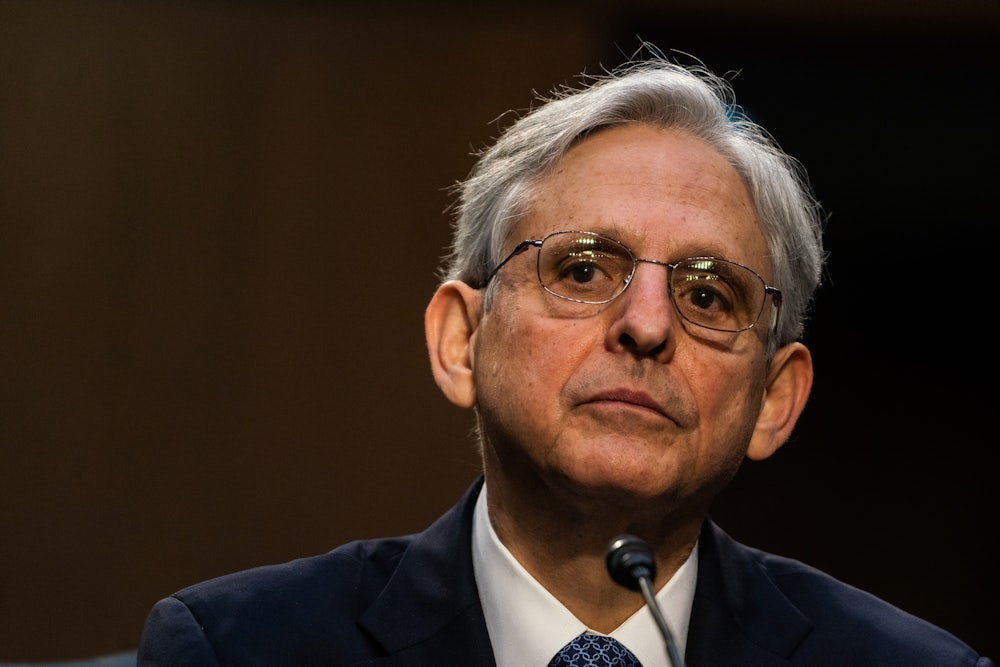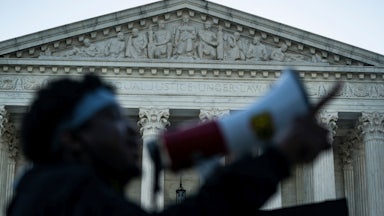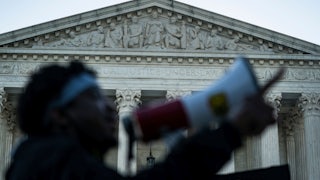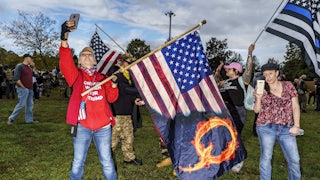If Merrick Garland is confirmed by the Senate and becomes the next attorney general, his first priority, according to the testimony he offered on Monday, would be supervising “the prosecution of white supremacists and others who stormed the Capitol on January 6.” In both his prepared remarks and his answers to senators’ questions, Garland framed the siege as an attack on American democracy itself, and the job of the Department of Justice as “battling extremist attacks on our democratic institutions.”
He likened what motivated Timothy McVeigh and Terry Nichols, whom he prosecuted for the bombing of the Alfred P. Murrah federal building in Oklahoma City in 1995, to what prompted the January 6 attack. He traced the Justice Department’s mission to its origins during Reconstruction, when it successfully prosecuted members of the Ku Klux Klan. This is the correct throughline to draw: From 2021 to 1995 to 1871, connecting the Capitol to Oklahoma City to South Carolina, where 150 years ago, after years of the Klan using violence to terrorize Black voters, disrupting elections with deadly force, the Department of Justice intervened.
Prosecuting far-right extremist violence is not an end unto itself. It cannot completely extinguish these groups, who, arguably, are not a break with American democracy but one steady fixture of it. But if Garland is acting from this sense of history, this understanding of what ground this prosecution is being fought on—white supremacy—offers a break with the calls that followed January 6 to pursue the rioters as “domestic terrorists.” As many have pointed out, we don’t need to look outside the United States to find an analog to this violence. The Klan’s terrorism is right there in our own past. And for a time, the state acted in opposition, when the Department of Justice saw it as its mission, as Garland recounted, “to secure the civil rights promised by the 13th, 14th, and 15th Amendments.” Yet within that history lies the failure that led to the events of January 6, 2021: What Garland did not mention is that the attorney general who brought those cases against the Klan, Amos T. Akerman, was dismissed less than two years after he was appointed by Ulysses S. Grant and that such prosecutions halted almost completely by 1876, as Reconstruction collapsed, after reactionary violence and institutional abandonment.
A century later, white supremacist and far-right groups surged, galvanized by anti-government sentiment in the wake of the raids at Ruby Ridge in Idaho in 1992 and the Branch Davidian compound in Waco, Texas, the following year. This is that later era Garland was referencing, culminating with the bombing in Oklahoma City, which killed 168 people and injured hundreds more. Scholars of far-right groups have drawn the many connections from that bombing to the Capitol attack—such as the fantasy of mass executions, as featured in The Turner Diaries, one of McVeigh’s go-to books. But, as extremist researcher J.M. Berger told journalist Leah Sottile on the BBC podcast Two Minutes Past Nine shortly after the attack, the Capitol rioters weren’t just referencing The Turner Diaries and its “day of the rope” when they placed a gallows and noose at the Capitol on January 6; that distinct threat and its visual terror go back to the days of lynching and the brutal end of Reconstruction.
Garland had the opportunity to lay out these connections during questioning on Monday. When Senator Dick Durbin asked the prospective attorney general if the Oklahoma City bombing was merely a one-off event, Garland was surefooted in his response: Not necessarily, he answered, citing the threat of continued white supremacist violence as identified by the FBI. “There’s a line from Oklahoma City, and there’s another line all the way back to the experiences I mentioned in my opening, with respect to the battles of the original Justice Department against the Ku Klux Klan.” Asked what’s different now, Garland replied, “We are facing a more dangerous period than we faced in Oklahoma City and at that time.”
One lesson to take from Amos T. Akerman and his Grant-era Klan prosecutions is that they worked, for some time, anyway. The Week’s Ryan Cooper urged Biden to take that to heart. “The point is to destroy the social tissue of rebellion—by demonstrating that crime will indeed be punished, by seizing the property and weapons of the insurrectionists, by disrupting their communications, by forcing them to put down arms or flee underground, and so on.” When Grant withdrew from that commitment, the violence that followed “established exactly the white supremacist terror state that Akerman had fended off before: Jim Crow.” The Klan, though compromised, would return in the 1910s and in successive waves for decades to come.
On January 6, while the Capitol was still occupied by people who had come carrying, variously, flex cuffs, bear spray, and a Confederate flag, the president-elect said on Twitter, “Let me be very clear: the scenes of chaos at the Capitol do not represent who we are.” They do—from the members of the military and law enforcement who joined or fomented the riot, to the people in the Department of Justice now tasked with investigating them. The history Garland invoked at his confirmation hearing in that same building, steps from where the QAnon follower Jacob Chansley stood in his horns and fur, reveals this, too: This has been who we are for the past 150 years.








